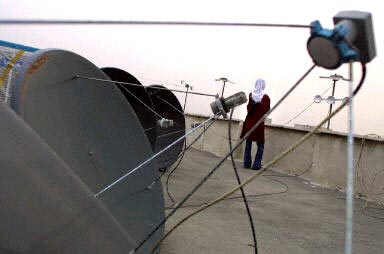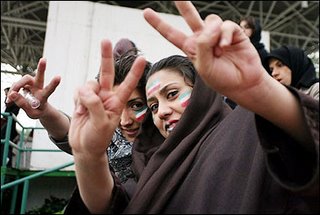Recently, Mahmoud Ahmadinejad's government notched up the battle against alternative and underground media and arrested more intellectuals, such as Dr. Ramin Jahanbegloo .

A mosaic of Persian satellite TV channels ;
©2006 O.Habibinia
Currently, they plan to broadcast "parasitically" on Persian satellite channels, which are quite popular in Iran. Moreover, Sepah-e-Pasdaran (the Islamic Guard) is responsible for carrying out the mission. This is the usual tactic of the regime when urban unrest threatens. In recent demonstrations, they have broadcast on the same frequency as the Persian satellite channels, but the tactic was not successful, as they disturbed the whole frequency band and did not succeed even in covering all of Tehran.
| |||||||||||||||||

Thirteen years ago, when I was in film school, our new professor, recently arrived from the U.S., excitedly described for us the premier of Robert Altman's Short Cuts, which was then his most recent film. He felt it a pity that we could not watch it in Iran. In response, we smiled and said actually that we had seen it the previous month! During the last 10 years, popular culture has influenced the state media more than the other way round. In Iran, more than 60 percent of urban families watch satellite TV. This forces Islamic TV (IRIB) to show more and more American and Western films and series at the same time. As lots of scenes and parts cannot appear on Islamic TV, they change the scenario or introduce special effects to make them suitable.This also happens to underground rock music.Whereas years ago no one could imagine an official rock concert by young local groups, now the government is forced to make exceptions for some that are not that dangerous!Of course, they continue to produce and broadcast religious series or programs, but the official polls show such fare attracts a smaller audience than any other kind of programming.On the other hand, about 35 Persian channels broadcasting from outside Iran cannot also satisfy a significant fraction of young Iranian viewers, who cannot fathom the political perspectives of old men answering phone calls on screen.
 Some months ago, the New York Times published a report on such awful programs by Persian TV stations based in Los Angeles.In a recent poll, most viewers of Persian satellite TV say they do not trust the political perspective of these channels.This process encourages the development of inside alternatives and underground media to express the nature of daily life in today's Iran, such as rock groups, blogs, and underground videos. These media, which Islamic censorship would prefer not to appear at all, portray the dual face of Iran, which daily gets less deniable.
Some months ago, the New York Times published a report on such awful programs by Persian TV stations based in Los Angeles.In a recent poll, most viewers of Persian satellite TV say they do not trust the political perspective of these channels.This process encourages the development of inside alternatives and underground media to express the nature of daily life in today's Iran, such as rock groups, blogs, and underground videos. These media, which Islamic censorship would prefer not to appear at all, portray the dual face of Iran, which daily gets less deniable. 2006-05-17 08:34 (KST) ©2006 OhmyNews












